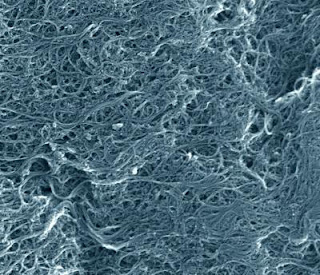The National Institute of Standards and Technology (NIST) has issued the world's first reference material for single-wall carbon nanotube soot. Distantly related to the soot in your fireplace or in a candle flame, nanotube-laden soot is the primary industrial source of single-wall carbon nanotubes, perhaps the archetype of all nanoscale materials. The new NIST material offers companies and researchers a badly needed source of uniform and well-characterized carbon nanotube soot for material comparisons, as well as chemical and toxicity analysis.
With walls of carbon only one atom thick and looking like a sheet of chicken wire curled into a cylinder, single-wall carbon nanotubes are one of several families of pure carbon materials that, because of their nanoscale size, have special properties. "Single-wall carbon nanotubes," says NIST chemical engineer Jeffery Fagan, "have exquisite optical, mechanical, thermal and electronic properties, and because of their small width but long lengths—think of something like a long piece of hair but 10,000 times thinner—full development of these materials should enable lighter, stronger materials, as well as improve many technologies from sensors to electronics and batteries."
Unfortunately, nanotubes are difficult to produce without significant impurities or in large quantities. Single-wall nanotubes, in particular, have been notorious for their relatively low quality and batch-to-batch variability. They typically are produced in complex processes using small particles of metal catalysts that promote the growth of the nanotubes. The resulting material—often a powder not unlike the soot you would find in your fireplace—has frequently contained large amounts of impurities, such as other forms of carbon, and sometimes significant levels of catalysts.
The new NIST product, Standard Reference Material (SRM) 2483, "Single-Wall Carbon Nanotubes (Raw Soot)," will directly address the issue of comparability. It is possibly the world's single largest supply of homogeneous, chemically analyzed, carbon nanotube soot where the uniformity of the samples from unit to unit is assured. Each unit of SRM 2483, a glass vial containing 250 milligrams of soot, is certified by NIST for the mass fraction values of several common contaminants: barium, cerium, chlorine, cobalt, dysprosium, europium, gadolinium, lanthanum, molybdenum and samarium. Reference values (values believed to be accurate, but not rising to the level of confidence that NIST certifies) are provided for an additional seven elements.
NIST also provides additional reference data useful for nanotube analysis, including thermal gravimetric and Raman data, as well as informational values for ultraviolet-visible-near-infrared absorbance spectra, near-infrared fluorescence spectra, Raman scattering spectra and scanning electron microscopy images. With these sets of information, purchasers of the material should be able to compare their results against the NIST values and against those from suppliers or after processing, ensuring a consistent point of comparison.
###
Single units of SRM 2483, "Single-Wall Carbon Nanotubes (Raw Soot)," are available from the NIST Standard Reference Materials Program at https://www.nist.gov/srm/. See https://www-s.nist.gov/srmors/view_detail.cfm?srm=2483 for details.
Standard Reference Materials are among the most widely distributed and used products from NIST. The agency prepares, analyzes and distributes more than a thousand different materials that are used throughout the world to check the accuracy of instruments and test procedures used in manufacturing, clinical chemistry, environmental monitoring, electronics, criminal forensics and dozens of other fields.
Contact: Michael Baum baum@nist.gov 301-975-2763 National Institute of Standards and Technology (NIST)
















No comments:
Post a Comment